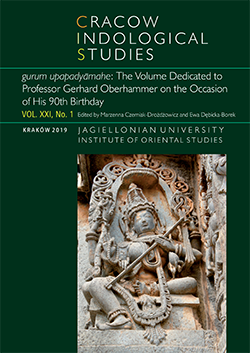Drowning in the Beauty of the Lord: A Glimpse at the Medieval Śrīvaiṣṇava Commentators’ Interpretation of the pādādi-keśa-varṇana of Tiruppāṇ Āḻvār’s Amalaṉātipirān
Drowning in the Beauty of the Lord: A Glimpse at the Medieval Śrīvaiṣṇava Commentators’ Interpretation of the pādādi-keśa-varṇana of Tiruppāṇ Āḻvār’s Amalaṉātipirān
Author(s): Suganya AnandakicheninSubject(s): Middle Ages
Published by: KSIĘGARNIA AKADEMICKA Sp. z o.o.
Keywords: Nālāyira Divya Prabandham; Śrīvaiṣṇava commentary; Tiruppāṇ Āḻvār; Amalaṉātipirāṉ; Periyavāccāṉ Piḷḷai; Aḻakiya Maṇavāḷa Perumāḷ Nāyaṉār; Vedānta Deśika
Summary/Abstract: This article explores how three medieval Śrīvaiṣṇava commentators— Periyavāccāṉ Piḷḷai (13th c.), Aḻakiya Maṇavāḷa Perumāḷ Nāyaṉār (14th c.) and Vedānta Deśikaṉ (14th c.)—deal with the passages that describe the different body parts of Raṅganātha, the main Deity in Śrīraṅgam, in Tiruppāṇ Āḻvār’s (9th c.) set of ten verses. Known as Amalaṉātipirāṉ (AAP),1 this decade, now part of the Nālāyira Tivviyap Pirapantam (or Nālāyira Divya Prabandham), follows the eyes of the poet, as they gradually move from the Deity’s foot to His head. The commentators make the most of these descriptions in order to emphasize the importance of beauty, which is visible, hence accessible, to everyone in His arcā (‘sacred icon’2) form and which is inextricably linked to His other attributes like sovereignty.
Journal: Cracow Indological Studies
- Issue Year: 21/2019
- Issue No: 1
- Page Range: 1-24
- Page Count: 24
- Language: English

